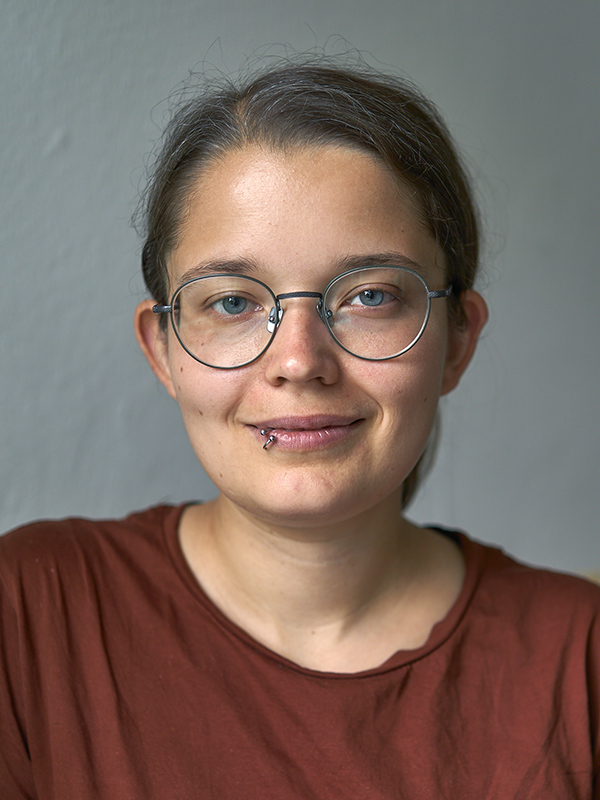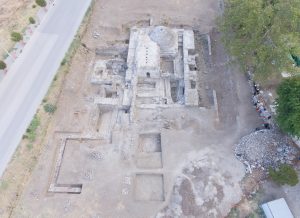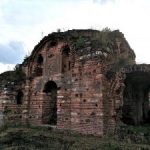
Julika Steglich, Kiel Üniversitesi’nde klasik arkeoloji alanında doktora adayı ve Gerda Henkel Vakfı bursiyeridir. Leipzig, Bonn ve Kiel Üniversitelerinde klasik, prehistorik ve protohistorik arkeoloji okuyan Steglich, Olynthus, Priene ve Pergamon’da su yönetimi (MÖ 5.–2. yüzyıl) üzerine teziyle 2018’de yüksek lisans derecesini aldı. Doktora tez projesinde, Roma imparatorluk döneminde Anadolu’daki termal hamamların bölgeye özgü özelliklerine ve bunların Bizans dönemindeki devamlılığına odaklanmakta. Projesinin temeli, Pergamon’un güneybatısındaki Kleopatra Ilıcası’nda 2018’de başlamış olup hâlen sürdürülen arkeolojik, mimari, jeofiziksel ve arkeo-hidrolojik saha çalışmasının bir analizinden oluşuyor. Steglich, ANAMED’deki bursiyerliği süresince, bu yapıyı Pergamon mikro bölgesi, Anadolu ve Akdeniz dünyası bağlamında incelemeyi planlamaktadır.
Research Title: Layout, Chronology, and Spatial Integration of Roman-Imperial Thermal Baths in the Microregion of Pergamon: The Kleopatra Güzellik Ilıcası
Ms. Steglich is a PhD candidate in Classical Archaeology at Kiel University and a fellow of the Gerda Henkel Foundation. She studied Classical Archaeology and Pre- and Protohistoric Archaeology at the universities of Leipzig, Bonn, and Kiel. She completed her master’s degree in 2018 with a thesis on water management in Olynthus, Priene, and Pergamon (5th – 2nd century BCE). In her dissertation project, she focuses on region-specific characteristics of Anatolian thermal baths in the Roman Imperial period and their continuity in Byzantine times. The basis of her project is formed by an analysis of current archaeological, architectural, geophysical, and archaeo-hydrological fieldwork at the Kleopatra Ilıcası southwest of Pergamon, which started in 2018. While at ANAMED, she is examining the building in the context of the Pergamenian Micro-region, Anatolia, and the Mediterranean World.
Fellow’s End of the Academic Year Research Report:
Layout, Chronology, and Spatial Integration of Roman-Imperial Thermal Baths in the Microregion of Pergamon: The Kleopatra Güzellik Ilıcası
Anatolian civilizations have a long tradition of bathing culture. Baths with highly developed water systems are found in Anatolia from the Bronze Age onwards. There is significant literature published about hygienic baths supplied by cisterns or aqueducts, which means that they were provided with cold rainwater or groundwater that had only low mineralization. In contrast, even though Anatolia is rich in thermal springs, we know very little about thermo-mineral baths and the connected bathing culture. Research on these thermo-mineral baths is necessary, as these baths were distinct from cistern- or aqueduct-supplied baths. The use of thermo-mineral water required different locations and different architecture for these bathing facilities. Also, the function of these building types differ from each other. In contrast to the hygienic baths, thermal baths were used for healing and only from the 2nd BCE for recreation and leisure, as well. Especially for the “golden age of public baths,”[i] the Roman era, we lack, with very few exceptions, systematic and published investigations on thermo-mineral bathing in Turkey. Recent detailed case studies mainly exist for such baths in Italy, Portugal, Spain, France, Germany, Israel, and North Africa. Moreover, a comprehensive survey of building types is still missing. Therefore, one goal of current research on this topic is to determine architectural and functional criteria which will assist in identifying thermo-mineral and healing baths and their regionally specific characteristics. Since this type of building has no standard layout due to their dependency on natural settings, we need a comprehensive database to identify typical traits.[ii]
My dissertation thesis contributes to this goal, focusing on Anatolian thermo-mineral baths of the Roman-Imperial period, presently underrepresented in archaeological research. It is part of the interdisciplinary project “Layout, Chronology and Spatial Integration of Roman-Imperial Thermal Baths in the Microregion of Pergamon: The Kleopatra Güzellik Ilıcası,” led by Prof. Dr Stefan Feuser (University of Bonn) and funded by the Gerda Henkel Foundation and the German Archaeological Institute, the DAI. The central part of my work is the fieldwork carried out by an interdisciplinary team that conducts archaeological, architectural, geophysical, and archaeo-hydrological investigations of the Kleopatra Güzellik Ilıcası thermal bath, located on the southwestern outskirts of modern Bergama near a public park (Fig. 1). We conducted this fieldwork between 2018 and 2021 within the framework of the Pergamon Excavation of the DAI, led by Prof. Dr Felix Pirson.[iii] The main part of my dissertation thesis is the synthesis and analysis of these different fieldwork disciplines’ results. My aim is a diachronic reconstruction of the Kleopatra Ilıcası, its building development, room functions, and decorative and technical equipment. I am especially focusing on the Roman phases of use and construction, along with transformations occurring in Byzantine times. In addition, I compare the building on a microregional and supraregional level. My analysis of the chronology, layout, and spatial integration of the Kleopatra Ilıcası and its contextualization will help determine whether there are region-specific characteristics of Pergamenian and, if possible, of Anatolian thermo-mineral baths in the Roman-Imperial period.
The Kleopatra Ilıca is located in Pergamon’s microregion. Pergamon is 30 km from the western coast of Asia Minor, situated on the northern edge of a rift valley, crossed from east to west by the Kaikos river. This valley has always been rich in thermal springs. So far, the remains of five thermal baths, probably all of the Roman-Imperial period, have been discovered in this area, including the so-called “Kurstadt” Allianoi. The Kleopatra Ilıca is the closest to Pergamon, situated in the foothills of the mountains. In the Roman-Imperial period, the thermal bath Kleopatra Ilıca was located outside of the urban zone of Pergamon, approximately 4 km from the lower part of Roman Pergamon and 2 km from the famous Asklepieion. The Asklepieion could probably be reached from the thermal bath through a valley. Moreover, we assume that the bath was located near a road that led to Elaia, the harbor of Pergamon. After the abandonment of the Roman-Imperial building, a bath complex was built over the area of the spring in the Ottoman period, incorporating parts of the ancient structure.

Fig. 1. Aerial photo of the Kleopatra Ilıca thermal bath from the southwest (Archive DAI Pergamon Excavation: D-DAI-PE2021-18917, B. Korkut).
In the months before I started as a PhD fellow at ANAMED during the academic year of 2021–2022, I participated in our third field campaign at the Kleopatra Ilıca for approximately seven weeks. Compared to the previous years, this campaign was the largest we have undertaken in terms of excavation and building survey. During this work, comparison of the newly exposed structures and the geophysical measurements (from 2018 and 2019), as well as the progressive evaluation of the finds, indicated significant changes in the interpretation of the architecture and building phases. That’s why I changed the work plan for my time at ANAMED. Originally, I wanted to focus on my microregional and supra-regional comparison chapters. Thanks to the ANAMED fellowship, the great support of the ANAMED staff, and my prolonged stay in Turkey, I was able to concentrate on the analysis of the 2021 fieldwork and to contextualize our new data with the results of the previous campaigns. I included this research in my main chapter of my dissertation thesis. I also benefited from the proximity of ANAMED to the German Archeological Institute of Istanbul. It allowed me to discuss results and administrative difficulties with colleagues of the Pergamon excavation directly and upload or download newly-produced data on the excavation server.
After the campaign, we still had the following questions: What were the dimensions of the building, especially in the south? How was our spa complex organized internally in the south? When was it built, and was the bath used continuously until modern times? What room functions can we reconstruct for the newly excavated rooms? To answer these questions properly, I returned to Bergama at the beginning of October for two weeks and finished the documentation in the field. Back in Istanbul, I started analyzing the stratigraphy in connection to the results of the finds processing and C14 dating, along with the newly excavated building structures. I attended meetings with our finds processors, Theresa Rafflenbeul, M.A. (Ruhr Universität Bochum), and Fabian Sliwka, M.A. (Universität Hamburg), and project manager Prof. Dr. Stefan Feuser, to discuss the dating, conservation, and composition of the finds. In this way, I was able to properly reconstruct the abandonment and reuse phases of the building from the Late Roman period to recent times. Furthermore, I began to compare the uncovered building structures with our geophysical measurements and other Roman thermal baths. The aim is to place our reconstruction of the dimensions of the building in the south, the entrance situation, and the room functions within the new results of the field campaign. To better understand the geoelectric measurement results, I participated in several meetings with our project partner, Dipl.-Geophys. Ercan Erkul (Kiel University). In addition to the ongoing discussions about our reconstruction with our head of the building survey, Dr.-Ing. Katja Piesker (German Archaeological Institute, Berlin), and my supervisor, Dr. Feuser, I have also started writing two articles with them. One will be the preliminary report of the campaign in 2021, and the other will be about our excavation in general for an E-research report of the DAI.
The stay in Istanbul has also allowed me to use the local libraries and ANAMED infrastructure to complete my literature research on the Pergamenian microregion and Anatolian thermal bath culture. Neither the Kiel Library nor other German libraries met these requirements completely. My study so far already confirms the lack of excavations and detailed investigations of Roman thermal baths in Turkey. With the completion of the literature research in Istanbul, I will be able to build upon my research and finish my dissertation.
Furthermore, the stay at ANAMED enabled me to establish and deepen contacts with other scholars from different disciplines and institutions. The exchange with the other fellows and colleagues of the Pergamon excavation was especially fruitful on an academic, methodological, and personal level. I also enjoyed gaining more insight into the different educational systems of Turkey, Italy, the UK, and the US.
Finally, I would like to thank Koç University and ANAMED for the support and funding of my project. Integrating the results of the 2021 campaign in my dissertation thesis would not have been possible without the fellowship. I look forward to presenting the results of my work at ANAMED at the International Conference of the Frontinus-Society on the History of Water Management and Hydraulic Engineering “Bathing Culture in Budapest” in September 2022.
[i] Fikret K. Yegül, “Bathing Culture of Anatolia: A Thousand Points of Light, A Thousand Fingers of Warmth,” in Bathing Culture of Anatolian Civilizations: Architecture, History, and Imagination, ed. Nina Ergın (Leuven—Paris—Walpole, MA.: Peeters, 2011), 15.
[ii] Yegül, “Bathing Culture,” 12–30; Emanuela Borgia, “Preliminary Considerations on Thermal Spas in the Eastern Roman Provinces: The Case of Asia Minor,” in Rethinking the Concept of ‘Healing Settlements’: Water, Cults, Constructions and Contexts in the Ancient World, eds. Maddalena Bassani, Marion Bolder-Boos, and Ugo Fusco (Oxford: Archaeopress Roman Archaeology 52, 2019), 81; Silvia González Soutelo, “Shall We Go “Ad Aquas”? Putting Roman Healing Spas On The Map,” Espacio Tiempo y Forma Serie I Prehistoria y Arqueología 12 (2019): 151–158, 171, https://doi.org/10.5944/etfi.12.2019.25939.
[iii] Stefan Feuser, Katja Piesker, and Ercan Erkul, “Das extraurbane Thermalbad Kleopatra Güzellik Ilıcası,” in Felix Pirson, “Pergamon—Bericht über die Arbeiten in der Kampagne 2018,” Archäologischer Anzeiger 2019, no. 2 (2019): 14–39, https://doi.org/10.34780/aa.v0i2.1005; Stefan Feuser, Julika Steglich, Katja Piesker, and Ercan Erkul, “Das extraurbane Thermalbad Kleopatra Güzellik Ilıcası,” in Felix Pirson, “Pergamon—Das neue Forschungsprogramm und die Arbeiten in der Kampagne 2019,” Archäologischer Anzeiger 2020, no. 2 (2020): 99–124, https://doi.org/10.34780/aa.v0i2.1025.

Fig. 2. Hagios Aberkios (Carlo Berardi).
In the meantime, I kept working on one of my chapters, dealing with the maturation of the chivalric aesthetic in the latter half of the twelfth century, and submitted a draft for a related article (still unpublished as of April 2022) centered around the precocious appearance of heraldic emblems in the church of St. Panteleimon at Nerezi in North Macedonia. The paper, provisionally titled “Brave as a Lion, Fierce like a Griffin. Heraldic Devices and Aristocratic Identity in the Frescoes of St. Panteleimon, Nerezi,” argues that the adoption of heraldic practices by the upper echelons of Komnenian aristocracy (the frescoes at Nerezi were commissioned by Alexios Angelos Komnenos, the ruling emperor’s cousin) is nearly contemporary to the codification of armorial devices in Western Europe and thus should not be merely regarded as a cultural import but investigated first as a relevant chapter in the development of heraldry, and chivalric culture as a whole, and second as an expression of the mutated aspirations and representational strategies of the military elites in Byzantium.
As part of my work on a different chapter, whose focus lies on the interaction between the new martial values of the aristocracy and the classical tradition, I have also presented a paper at the 24th International Graduate Conference of the Oxford University Byzantine Society (OUBS), entitled “Old Tales Told Anew: Homeric Heroes and Komnenian Ideals in the Illustrations of the Marciana Iliad,” which was later selected for publication in the conference proceedings and will appear in an edited volume, most likely in 2024. The talk centered on the illustrations added to the codex Venetus A (Marc. Graec. Z 454), the oldest extant manuscript of the Iliad, at some point in the mid-twelfth century. These miniatures precede the text of the Iliad proper, both physically and narratively, as they depict events that occurred before the beginning of the poem. I argued that the selection and sequence of the episodes, together with the use of twelfth-century garb and material culture in association with the characters, reflect the evolving relationship between the Byzantine elites and the Homeric tradition, which was “updated” to better conform to the realities of contemporary warfare, on one hand, and to incorporate new courtly ideals, on the other. These efforts are mirrored in the works of twelfth-century intellectuals, such as John Tzetzes and Constantine Manasses, who were tasked with expounding, re-elaborating, and sometimes actively rewriting the Iliad to cater to the changing expectations of the Komnenian audiences. By underscoring the many similarities shared between these texts and the Marciana Iliad’s miniatures, I showed how the Komnenian elites re-imagined the Homeric epos through the lenses of different genres, such as the romance, and archetypes, such as that of the mounted warrior.
Many of these ideas could not have been developed and conceptualized in this form without the stimulus provided by the cross-disciplinary discussions that I had with the other fellows, both informally and in the semi-formal setting of the weekly ANAMED talks, the conversations that I had with other Byzantinists at the Swedish Institute (facilitated and encouraged by Koç University faculty), or the consultation of the center’s well-provisioned library. The constant feedback from my peers and senior scholars, and ANAMED’s conducive work environment, also contributed to me being awarded the M. Alison Frantz Fellowship by the American School of Classical Studies in Athens for 2022–2023. In conclusion, my stay in Istanbul proved to be fruitful and enjoyable, despite the looming presence of the Covid-19 pandemic, and constituted an essential step towards the completion of my dissertation.

